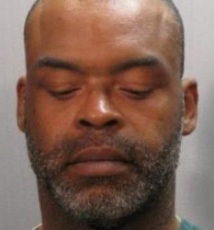Another white woman who doesn’t read VFR is murdered by her black boyfriend
When I began reading the below
article from the
Richmond Times-Dispatch, I hadn’t noticed the small captionless photo of a man at the top of the article and was not sure if the race of the suspect was known. Then, as the article unfolded, telling me, bit by intensifying bit, in a kind of liberal self-parody, more and more about the obviously dangerous nature of the man whom the good-hearted hippie-like divorced 44-year-old mother-of-two Sarajane Hakopian had welcomed into her life, I figured he sounded like a black man, except that his name, Brian Mallory, didn’t sound at all black. So, believe it or not, I wasn’t sure that he was black, even though the reader who had sent me the article had said he was black (it’s easy to be wrong about these things, and I try, most of the time, not to jump prematurely to conclusions).
The first remarkable thing about the piece is the title:
Was caring nature a factor in Sarajane Hakopian’s death?
Of course that is a theme I am forever sounding, about
Eloi women who give their caring, loving, incorrigibly naive and needy selves to rough and uncaring men of different race, usually black, sometimes Hispanic or Muslim, who then kill them. I describe such relationships and such murders as both the ultimate concrete result and the ultimate symbol of liberalism. But I don’t remember a mainstream news story about such a murder ever sounding that un-PC note of realism before.
The article starts out in idyllic tones about how Sarajane Hakopian was the “kindest soul” in Montpelier, Virginia, “the heart of what Montpelier is all about,” as one friend called her. “You always saw her with her tea, inseparable. She was a friend to everyone she met.”
Then the article says that Hakopian was found dead Monday afternoon, and that Brian Mallory is the suspect.
Then we learn that Mallory is a convicted felon, who started mowing Hakopian’s lawn and became her lover, partner, hook-up, or whatever word we’re supposed to use.
Then we learn that Hakopian had two children living with her from an ended marriage. (How many murdered white women have left their husbands, cutting themselves off from a responsible, protective male presence in their life, and are living with men not their husbands?)
Then we learn that there also lived at the house “a parade of young people whose families wanted their offspring to share in Hakopian’s nurturing but strict ways.”
Then we learn that Mallory was convicted of a “brutal armed robbery” 20 years ago, and that he is 6 feet, 4 inches tall and weighs 325 pounds.
Then we learn that notwithstanding the warnings from friends about being involved with such a man, Hakopian “saw no boundaries associated with color, religion, political beliefs or social standing”—the only reference to race in the article. I should add that warnings from friends are almost unheard of in these stories of white women killed by their black boyfriends. In almost every such article I’ve seen, everyone around the woman, including her useless brain-dead Eloi parents if they are in the picture, seems completely approving and accepting of the relationship, and no one takes her aside and tells her that she might be putting herself at risk—because, of course, that would be discriminatory and racist, and, perhaps an even more compelling reason for remaining silent, to warn your friend or sister or daughter away from a relationship with a black criminal thug and thus harm the erotic diversity of our society would be a greater tragedy than preventing her murder. In any case, when I read that line about how Sarajane saw no boundaries associated with color I finally concluded, slow reader that I am, that Mallory had to be black.
Then the article said that in February 1991 Mallory “was sentenced to 90 years in prison for robbery, kidnapping and firearms convictions with 56 years suspended.”
It was only then that I noticed the tiny uncaptioned photo of a black man at the top of the article and realized this was Mallory. Here is a larger version of the same photo, along with one of Hakopian:


Sarajane Hakopian and Brian Mallory
Here is the article:
Was caring nature a factor in Sarajane Hakopian’s death?
Sarajane Hakopian wasn’t so much the unofficial mayor of Montpelier as she was its kindest soul.
“Everybody knew her; she was the heart of what Montpelier is all about,” said Kelly Gandara, a friend for 10 years. “You always saw her with her tea, inseparable. She was a friend to everyone she met.”
Hakopian, 44, was discovered dead Monday afternoon by a neighbor inside her log-cabin-style home on Beaverdam Road, three miles south of the Hanover County village that gives the road its name. Hanover sheriff’s officials have not yet released a cause of death, but they are investigating the case as a homicide.
A tea kettle lawn ornament still marks the driveway—along with the sign just inside the gate that reads, “Close the Beaverdam gate!”
Brian S. Mallory, 42, of the 15100 block of Dunn Road in Montpelier was arrested in a bus station in Jacksonville, Fla., shortly before 1 a.m., Tuesday. Hakopian’s minivan was found nearby, according to authorities. Mallory is charged with grand larceny but is under investigation in Hakopian’s death, police said.
The minivan had several bumper stickers, among them “coexist.” The word exemplifies Hakopian’s love and care for all people, her friends said Tuesday. But it also may have helped lead to her death.
Police described Mallory as Hakopian’s boyfriend. Associates said Tuesday that the friendship with the convicted felon began when Mallory worked cutting Hakopian’s grass. His hired-hand status blossomed into something more serious that saw Mallory move from his squalid life on a dead-end road to a loving home where chickens, roosters and a pig had free range of the house.
Hakopian’s two young children from an ended marriage lived there as well, as did from time to time a parade of young people whose families wanted their offspring to share in Hakopian’s nurturing but strict ways.
Mallory, who has diabetes and at the time of his conviction in a brutal armed robbery 20 years ago stood 6 feet, 4 inches and weighed 325 pounds, was something else. “We used to tell her, ‘Don’t mess with the guy,’” said Frank Smith, who works at an auto shop near Mallory’s home. “I used to give him rides, but he was not a good person for her to be around.”
Hakopian, though, saw no boundaries associated with color, religion, political beliefs or social standing. She sang in the choir at Mt. Zion Baptist Church in Bumpass and was the president of the Lady’s Auxiliary for American Legion Post 90, whose chapter house is across the street from her home.
“The American Legion has lost one of its own, Sarah Jane Hakopian, [who] was murdered in her home in Beaverdam, Va.,” a posting Monday night stated. “She will be greatly missed by all of us. We ask that everyone pray that her two children, P.J. & Molly, that they will find some kind of peace in this horrible loss. We Love You Sarah!”
Virginia Department of Corrections records show Mallory has a history of felonies in Hanover dating to February 1991, when he was sentenced to 90 years in prison for robbery, kidnapping and firearms convictions with 56 years suspended.
Ray’s Quick Stop, located off Pouncey Tract Road, was a target.
“They come in and put the gun on my nose,” Barbara Koenig, an owner then, said Tuesday. “I’ll never forget it. There was three of them. My son was so scared—he was just a little thing then—he slept with a BB gun.”
Mallory was convicted of probation violations in January 2006, when he was given seven years in prison, part of the suspended sentence from the earlier convictions. He was released in October 2009 and ordered to supervised probation in Ashland.
Mallory, in tight blue script letters, wrote from prison, trying to persuade a Hanover judge to let him go free back in 2006.
“I have simply come to just allow the world to see who I am without fear, because I am basically a kind, caring soft spoken person that have kept hidden most of my life because of my large stature,” he wrote.
“I am sure you would see that I am a descent, respectful person that could really use for help you aid and assistance.”
The judge scribbled his reaction on a Post-it Note: “Whatever it is that he wants is denied.”
Hakopian’s gifts live on.
“She would stop me on the road out front of my house—she’d be driving down here picking up cans—and just ask me if I needed a hand, if I needed a ride,” said Glenda Morris, who lives on Bethany Church Road. Said Gandara: “I can’t imagine her ever doing anything to anyone that would make them mad at her. It is a loss to everyone.”
bmckelway@timesdispatch.com (804) 649-6601
[end of article]
Here is a VFR
post from just a month ago, about an almost identical relationship that ended with an almost identical murder, 55 year old Seattle English teacher Prudence Hockley beaten to death by her ex-con, parole-violating, black bodybuilder boyfriend, Johnnie Lee Wiggins:

Maybe Sarajane and Prudence will get together in the afterlife and compare notes about where they went wrong. I mean, liberals have to start realizing the insanity of their beliefs and behavior sometime, somewhere, don’t they?
- end of initial entry -
Daniel B. sent the article with this note:
I thought you would be interested in this article from the Richmond Times Dispatch which half heartedly acknowledges that this woman made a poor decision when she started dating a black man who was a violent convicted felon. The headline reads “Was caring nature a factor in Sarajane Hakopian’s death?” I was struck by the fact that the paper had the gumption to make a value judgement about the way this women led her life and suggested that her openness may have contributed to her untimely and violent death.
I must say I found the closing quote to be disturbing. Says an acquaintance of the victim: “I can’t imagine her ever doing anything to anyone that would make them mad at her. It is a loss to everyone.” The fact that this person looks towards a fault within the victim rather than the perpetrator reminds me of the incident of the disgruntled black man in Connecticut, Omar Thornton, who went postal at his place of employment. His rage was treated by the media as understandable, since he told police, after the murders, that his employers and co-workers had racially discriminated against him.
LA replies:
See the collection about the Connecticut beer distributorship incident: “VFR entries on a mass murder of whites by a black, which the media tacitly justified because the killer said his victims were racists.”
Posted by Lawrence Auster at February 01, 2012 11:48 PM | Send


